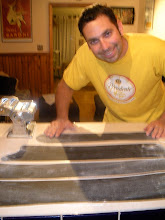While I've got a few moments, I thought I'd discuss the complexity of pasta dough. Many people say, "You'll have to tell me how you make your dough," which, I would love to do, but it's just not that easy.
Virtually every type of pasta that we make has its own formula and/or feel. Naturally there are types of pasta that
do use the same dough, and there are some that
could use another's formula, but it just wouldn't be the same. Unfortunately for me, I'm tied to tradition. Innately, I need to make a type of pasta the way it was many, many years ago and have a very difficult time deviating from any traditional method. I admire people and companies that are able to make their mark on the pasta world by creating new products or that have an "out with the old" philosophy. Ancora Pasta is exactly the opposite: we want to go back in time and create the same pasta that my relatives made in the Old Country, which, ironically could be construed as a new product.
I'll give you an example of how one type of dough differs from another despite outwardly appearing to be very similar. O
recchiette (little ears) is a pasta that has its origins in southern Italy, and more specifically, Bari (near the little "heel"), which is where my uncle (Giacomo Cappabianca) comes from. In this area, durum-wheat (semolina) flour was, and still is, the mainstay for many pasta dough recipes. So when we make
orecchiette, we need nothing more than semolina, salt, and water (a touch of wheat flour was common if handy to help soften the dough). These are the exact ingredients that are used to make
cavatelli, which is very similar in shape to
orecchiette. However, the difference lies in two areas: amount of flour and temperature of water. What? Temperature of water? Yes, you read correctly. The temperature of the water used in the dough-making process is crucial for many different types of dough.
Orecchiette, as mentioned earlier, has its roots in Bari, which is a small fishing city with beautiful views of the Adriatic; hence, the recommended
condimento with this dish would be a great puttanesca with chunks of fish and anchovy that will easily attach themselves to the roughed-up surface or dimple on the backside of the pasta. Just like our fishermen here in Maine, a hearty dish is crucial to maintaining stamina and working through the grueling hours required to make a living.
So let's compare that to a pasta dough found farther north:
garganelli, which is primarily from the Emilia-Romagna region, where some of the greatest cooking ingredients in the world originate (think parma ham & parmigiano). For this dough, let's grab some eggs, flour (tipo 00 and semolina), water, salt, nutmeg, and some grated parmigiano reggiano - one of the best cheeses in the world, so why not use it? You're already seeing the differences between the simplicity of the poorer southern ingredients and those of the more affluent province in the north (not rich by any means, just rich in resources). These of course are all combined and a dough is formed like most all other pasta doughs. The trick with this pasta is letting it dry just

enough so when rolling it on
il pettine ed il ferretto (the comb and iron/tool - now you're getting how we came up with the name for this blog...) it doesn't stick to the utensils. But wait! Not too dry otherwise the pasta will not stick to itself or be too brittle to work with. Oh those tricky Italians...There are actually some pictures on our Facebook page that show the
garganelli being made if you care to take a look. We will be selling these at the next farmers' market. Serve this with a nice, hearty
ragu, which is perfect for sticking to the ridged lines and inside the hollow tubes.
I definitely wrote more than I was anticipating, but there you have it. Two types of pasta in two different parts of the country and two completely different doughs based on local ingredients. I'll post this and see if I can figure out how to post some accompanying photos to elucidate all that was said...
Ciao a tutti!









